I need to generate random numbers with following properties.
Min should be 200
Max should be 20000
Average(mean) is 500.
Optional: 75th percentile to be 5000
Definitely it is not uniform distribution, nor gaussian. I need to give some left skewness.
I need to generate random numbers with following properties.
Min should be 200
Max should be 20000
Average(mean) is 500.
Optional: 75th percentile to be 5000
Definitely it is not uniform distribution, nor gaussian. I need to give some left skewness.
Java Random probably won't work because it only gives you normal(gaussian) distributions.
What you're probably looking for is an f distribution (see below). You can probably use the distlib library here and choose the f distribution. You can use the random method to get your random number.

Say X is your target variable, lets normalize the range by doing Y=(X-200)/(20000-200). So now you want some Y random variable that takes values in [0,1] with mean (500-200)/(20000-200)=1/66.
You have many options, the most natural one seems to me a Beta distribution, Y ~ Beta(a,b) with a/(a+b) = 1/66 - you have an extra degree of freedom, which you can choose either to fit the last quartile requirement.
After that, you simply return X as Y*(20000-200)+200
To generate a Beta random variable, you can use Apache Commons or see here.
This may not be the answer you're looking for, but the specific case with 3 uniform distributions:
 (Ignore the numbers on the left, but it is to scale!)
(Ignore the numbers on the left, but it is to scale!)
public int generate() {
if(random(0, 65) == 0) {
// 50-100 percentile
if(random(1, 13) > 3) {
// 50-75 percentile
return random(500, 5000);
} else {
// 75-100 percentile
return random(5000, 20000);
}
} else {
// 0-50 percentile
return random(200, 500);
}
}
How I got the numbers
First, the area under the curve is equal between 200-500 and 500-20000. This means that the height relationship is 300 * leftHeight == 19500 * rightHeight making leftHeight == 65 * rightHeight
This gives us a 1/66 chance to choose right, and a 65/66 chance to choose left.
I then made the same calculation for the 75th percentile, except the ratio was 500-5000 chance == 5000-20000 chance * 10 / 3. Again, this means we have a 10/13 chance to be in 50-75 percentile, and a 3/13 chance to be in 75-100.
Kudos to @Stas - I am using his 'inclusive random' function.
And yes, I realise my numbers are wrong as this method works with discrete numbers, and my calculations were continuous. It would be good if someone could correct my border cases.
You can have a function f working on [0;1] such as
Integral(f(x)dx) on [0;1] = 500
f(0) = 200
f(0.75) = 5000
f(1) = 20000
I guess a function of the form
f(x) = a*exp(x) + b*x + c
could be a solution, you just have to solve the related system.
Then, you do f(uniform_random(0,1)) and there you are !
Your question is vague as there are numerous random distributions with a given minimum, maximum, and mean.
Indeed, one solution among many is to choose max with probability (mean-min)/(max-min) and min otherwise. That is, this solution generates one of only two numbers — the minimum and the maximum.
The following is another solution.
The PERT distribution (or beta-PERT distribution) is designed to take a minimum and maximum and estimated mode. It's a "smoothed-out" version of the triangular distribution, and generating a random variate from that distribution can be implemented as follows:
startpt + (endpt - startpt) *
BetaDist(1.0 + (midpt - startpt) * shape / (endpt - startpt),
1.0 + (endpt - midpt) * shape / (endpt - startpt))
where—
startpt is the minimum,midpt is the mode (not necessarily average or mean),endpt is the maximum,shape is a number 0 or greater, but usually 4, andBetaDist(X, Y) returns a random variate from the beta distribution with parameters X and Y.Given a known mean (mean), midpt can be calculated by:
3 * mean / 2 - (startpt + endpt) / 4